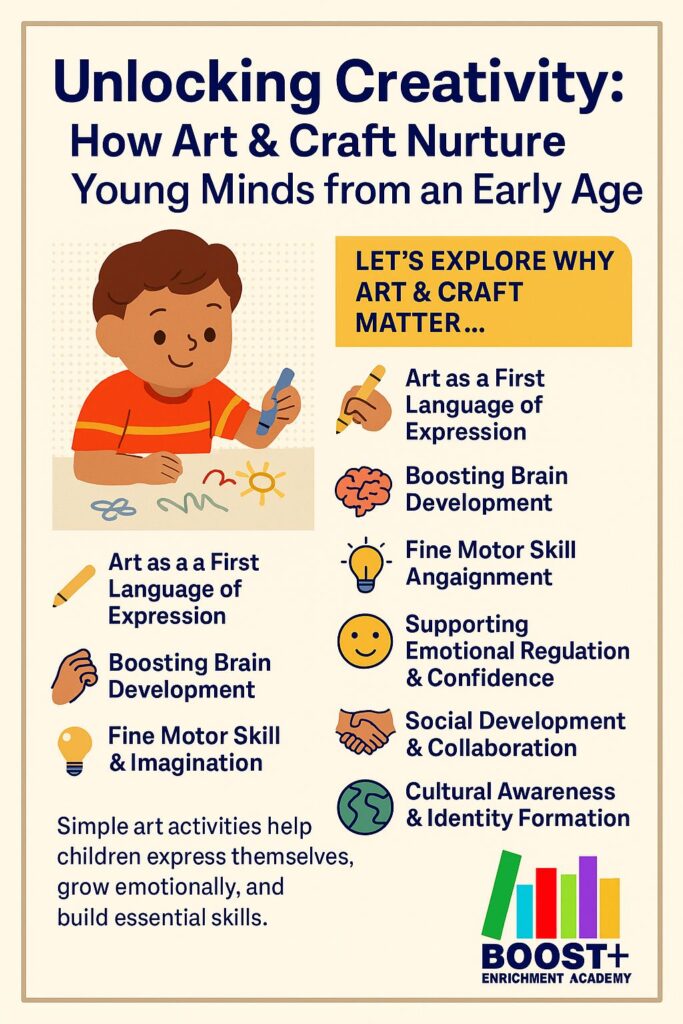Childhood is a time of wonder, exploration, and growth. It’s also a time when the foundation of a child’s emotional, cognitive, and physical development is laid. One of the most powerful tools to support this holistic growth—often overlooked in favor of academic readiness—is art and craft. Whether it’s finger painting, paper tearing, coloring, or making a collage, these simple activities are much more than just play. They are essential exercises in creativity, communication, and brain development.
Introducing art and craft early in a child’s life is not about creating a masterpiece. It’s about creating space for imagination, boosting emotional expression, improving motor skills, and nurturing confidence. Let’s explore why art and craft matter so much in the early years and how they help children grow the right way.

1. Art as a First Language of Expression
Before children learn to talk, draw letters, or write full sentences, they communicate through gestures, scribbles, and pictures. A red crayon may become a sun, or random dots may tell a story only they understand. This freedom of expression helps them make sense of the world around them.
Why This Matters:
- Developing emotional awareness: Art gives children a safe outlet to express feelings like joy, fear, anger, or excitement, even when they don’t have the words for them yet.
- Building communication skills: Describing their artwork helps children practice storytelling, expand vocabulary, and build the confidence to share ideas.
2. Boosting Brain Development
When children engage in art and craft activities, they are doing more than playing—they are building and strengthening brain connections. These experiences activate multiple areas of the brain, including those responsible for vision, motor coordination, memory, and problem-solving.
How it Helps:
- Strengthens neural pathways through repeated use of hands, fingers, and eyes.
- Encourages decision-making and critical thinking when choosing materials, colors, or how to fix a mistake.
- Enhances concentration and focus, as many art activities require children to follow sequences, patterns, or complete projects.
3. Fine Motor Skill Development
From holding a paintbrush to folding paper, art and craft activities require controlled, small movements. These seemingly simple motions are building blocks for essential life skills, such as writing, cutting, buttoning clothes, and even eating independently.
Key Benefits:
- Improves hand-eye coordination
- Strengthens finger muscles and dexterity
- Prepares children for writing and other academic tasks
4. Encouraging Creativity and Imagination
Early exposure to open-ended art activities helps children think in new ways, explore different perspectives, and take creative risks. They learn there is no “wrong way” to do art, which fosters a sense of freedom and possibility.
In a world where structured academics can start as early as preschool, art offers a much-needed outlet for innovation. This kind of creativity doesn’t just make better artists—it creates problem-solvers, inventors, and adaptable thinkers.
5. Supporting Emotional Regulation and Confidence
Art is also a therapeutic experience for young children. The soothing nature of repetitive motions (like coloring, kneading clay, or gluing pieces) can help children relax and manage their emotions.
Over time, completing art projects and receiving encouragement from parents or teachers builds a child’s self-esteem. They begin to trust their choices and feel proud of their creations.
Art Helps Children:
- Self-soothe when overwhelmed
- Process emotions in a healthy, non-verbal way
- Celebrate their individuality and uniqueness
6. Social Development and Collaboration
When done in group settings like preschools, daycare centers, or playdates, art and craft also promote social interaction. Children learn to share materials, wait their turn, give and receive feedback, and appreciate others’ work.
Activities like group murals or collaborative crafts foster teamwork, empathy, and appreciation for diversity—valuable life skills that go far beyond the classroom.
7. Cultural Awareness and Identity Formation
Art gives children a way to explore their culture, heritage, and traditions. Whether it’s making Diwali lanterns, coloring Rangoli patterns, or painting scenes from folktales, these creative expressions deepen a child’s sense of identity and belonging.
Similarly, exposure to different artistic traditions fosters tolerance and curiosity about other cultures—nurturing inclusive, open-minded future citizens.
Easy and Engaging Art Activities for Young Kids (Ages 1–5)
You don’t need fancy materials or structured lessons to get started. Here are some simple, developmentally appropriate activities:
- Finger painting with non-toxic paints
- Tearing and pasting paper onto a collage
- Sponge or vegetable stamping
- Nature art using leaves, sticks, or flowers
- Salt dough sculptures
- Threading beads onto a string
- Making puppets from paper bags or socks
- Drawing with crayons or sidewalk chalk
Pro tip: Focus on the process, not the end result. The magic happens during the messy middle—not the finished product.
How to Encourage Art at Home
- Set up a dedicated space with child-safe materials
- Keep supplies easily accessible to encourage spontaneous creativity
- Display your child’s artwork proudly to build confidence
- Participate with them—don’t just supervise, get creative together!
- Avoid criticism or “fixing” their work. Let them take the lead.
Final Thoughts: Art is Not Optional—It’s Essential
In today’s fast-paced, tech-driven world, the importance of art and craft in early childhood cannot be overstated. These simple creative activities lay the foundation for emotional intelligence, academic readiness, and social competence. More importantly, they allow children to explore the world, express themselves freely, and grow into confident, imaginative individuals.
So the next time your toddler is making a mess with paints or your preschooler is building a lopsided sculpture, smile and let it happen. You’re not just nurturing an artist—you’re shaping a whole human being.

